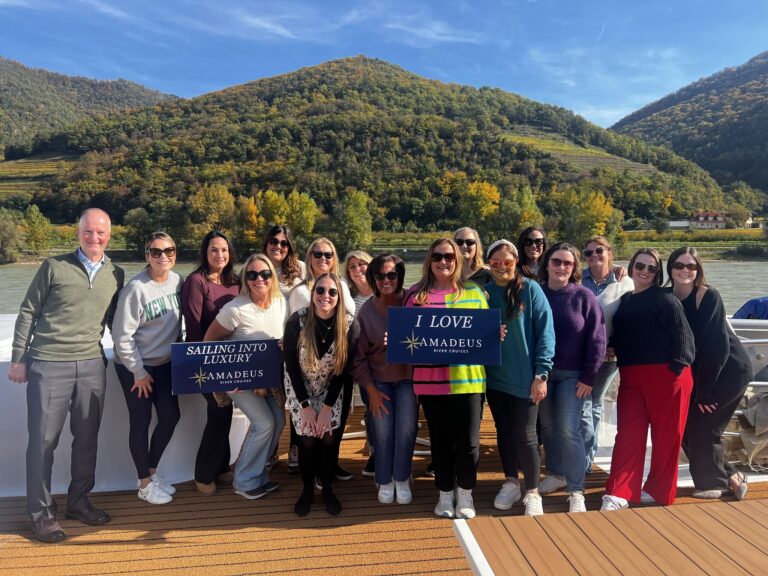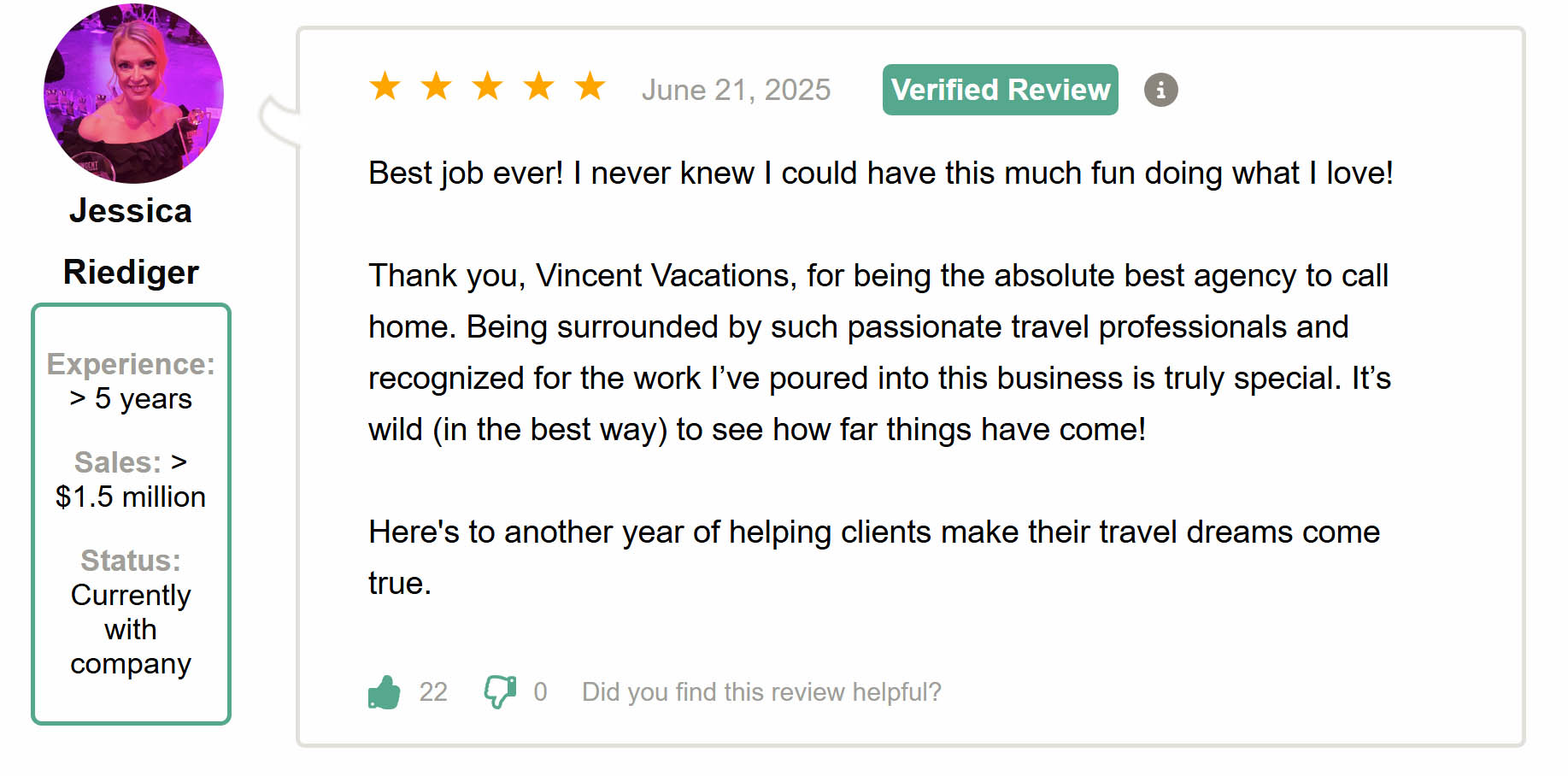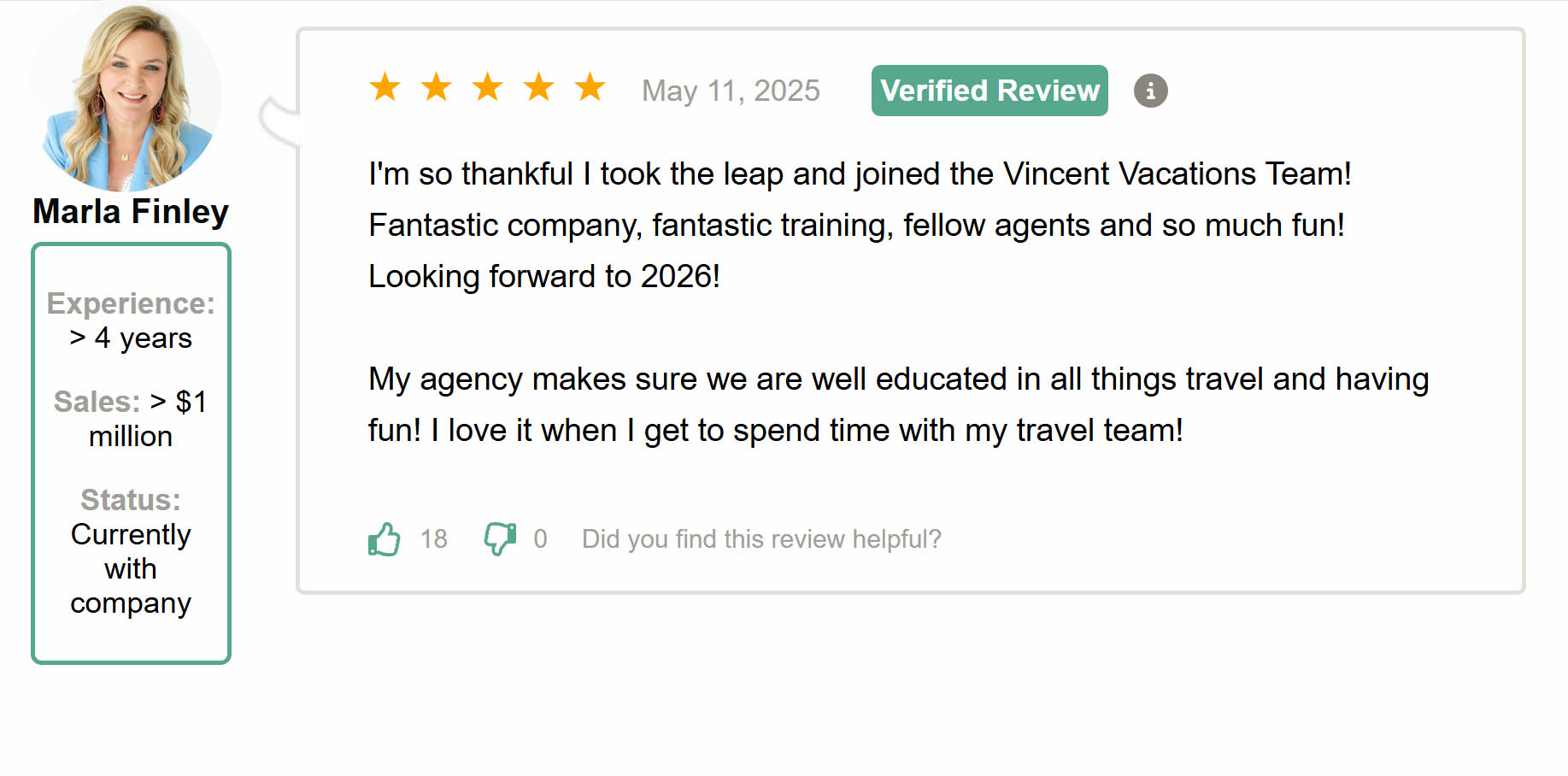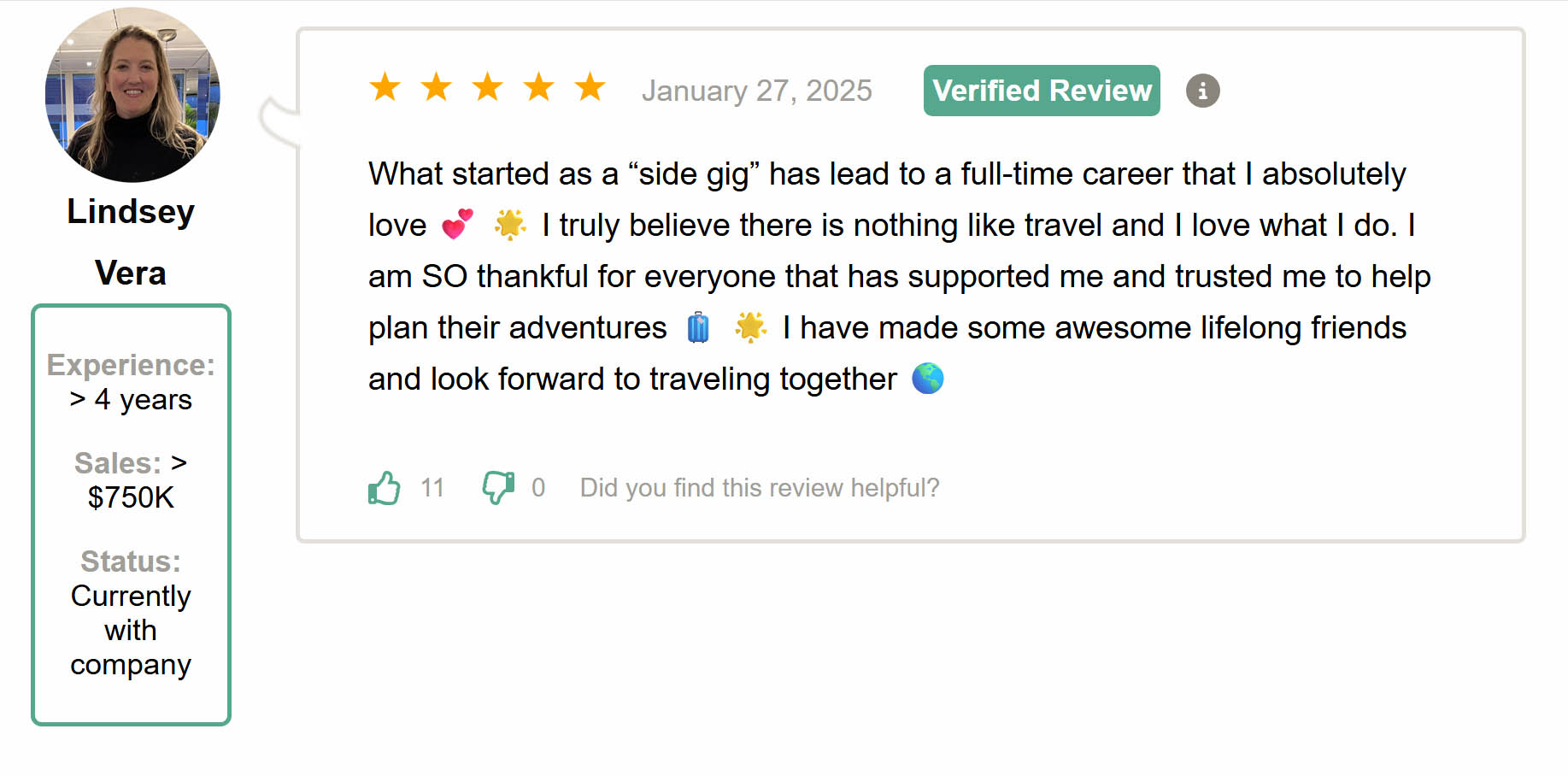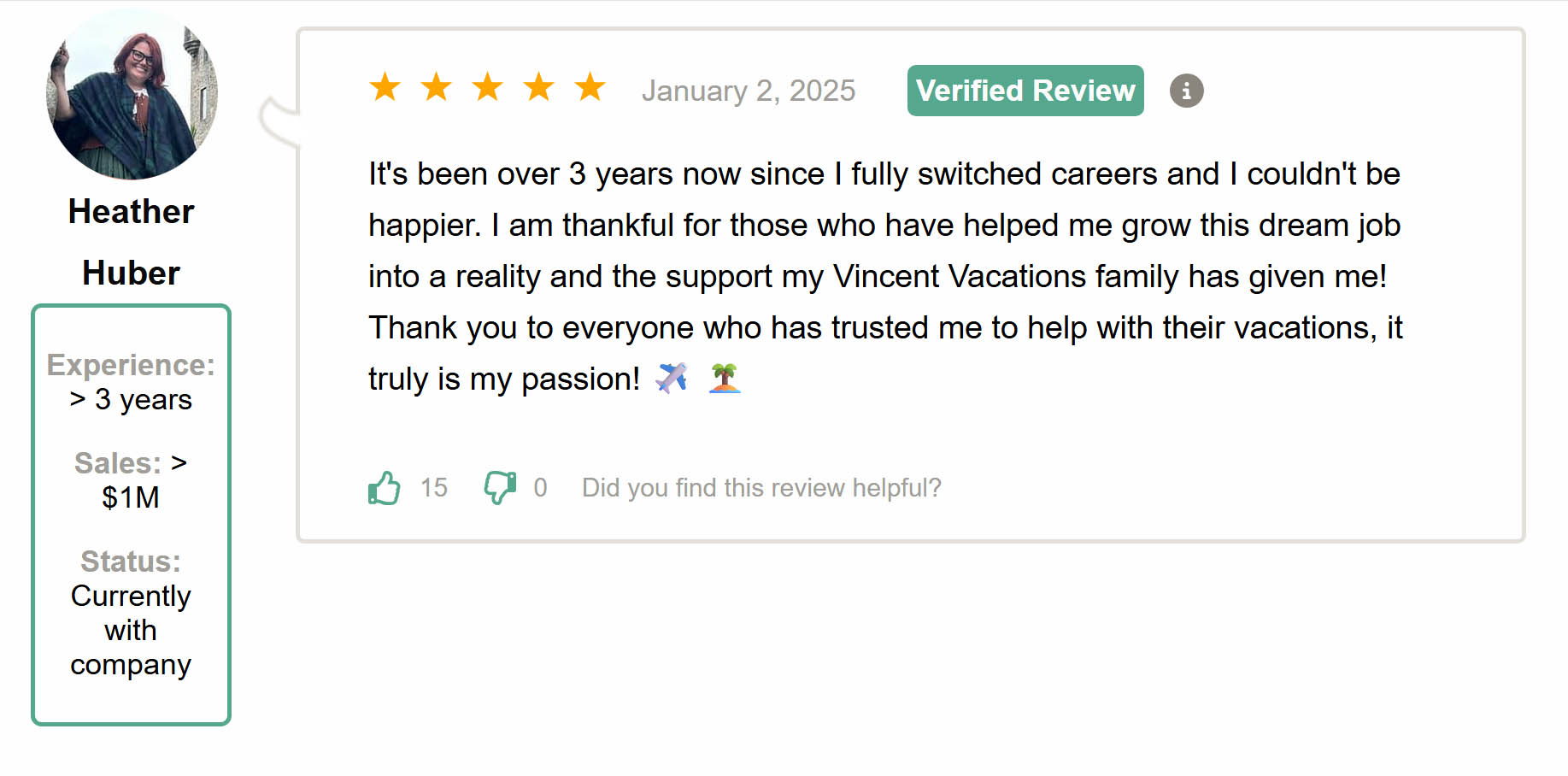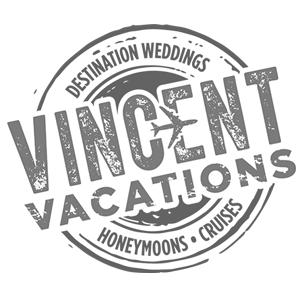Online Marketing Trip Planning Checklist
To learn more techniques and how to become a travel agent, sign-up to become a travel agent today!
Are you a travel agent who has an upcoming trip?
Do you want to use content from this trip to gain new customers online? To ensure you are maximizing your experience for marketing and converting clients, you need an "Online Marketing Trip Planning Checklist".
This checklist provides a guide for travel agents through a trip's entire cycle, helping you create engaging, professional content that appeals to niche audiences and converts followers into clients.
The guide below covers the essential steps to help you make the most of your upcoming trip for online marketing, from pre-trip planning to post-trip analysis.
Online Marketing Trip Planning Checklist Guide: Maximizing Your Upcoming Trip for Online Marketing and Client Growth
Table of Contents
- Overview of Using Your Upcoming Trip as a Marketing Tool
- Goals of This Guide
- Benefits of Marketing Your Trip Online
- Defining Your Target Audience
- Outlining Key Messaging for Your Trip
- Researching Destination-Specific Content
- Setting Goals for Content Engagement and Lead Generation
- Research Who and What Are Already Successful
- Selecting Content Types: Photos, Videos, Blog Posts, and Reels
- Mapping Out a Content Calendar
- Brainstorming Destination Highlights to Feature
- Planning Interviews or Partnerships with Local Experts
- Essential Equipment Checklist: Cameras, Drones, Tripods, Lighting
- Tech Tools and Apps for Editing and Scheduling
- Packing Props for Consistent Branding
- Quick Tips for Travel Gear Organization
- Pre-Trip Teasers and Announcements
- Identifying Trending Hashtags and Tags
- Planning Content for Different Platforms (Instagram, Facebook, TikTok, YouTube, etc.)
- Scheduling Posts Ahead of Time
- Crafting Captivating Trip Announcements and Teasers
- Developing Calls-to-Action for Engagement and Inquiries
- Preparing Templates for Responding to Comments and DMs
- Setting Up a “Behind the Scenes” Story Plan
Creating a Brand Consistent Look
- Establishing a Color Palette and Editing Style
- Tips for Taking High-Quality Photos and Videos
- Adding Captions and Text to Videos to Increase Engagement
- Brand Voice and Tone for Posts
- How to Connect with Local Businesses and Influencers
- Planning Meetups with Potential Clients or Partners
- Taking Advantage of Destination Experiences for Content
- Gaining Exclusive Access or Experiences for Unique Content
Trip Itinerary Planning for Content
- Organizing Destinations to Maximize Content Opportunities
- Identifying “Must-Capture” Locations and Experiences
- Balancing Work and Personal Time for Authentic Content
- Tips for Maximizing Downtime with Micro-Content
- Organizing and Editing Content for Future Posts
- How to Build Engagement Momentum Post-Trip
- Using Trip Content for Blog Posts, Newsletters, and Guides
- Following Up with Leads Generated from Trip Marketing
Measuring Success and Analyzing Results
- Tracking Engagement, Reach, and New Client Leads
- Evaluating What Worked and What Didn’t
- Setting Goals for Future Trips Based on Data
- Leveraging Insights for Future Marketing Strategies
- Recap of Key Takeaways
- Planning for Future Trips and Marketing Growth
- Keeping Momentum and Consistency in Your Marketing Strategy
Introduction

Overview of Using Travel as a Marketing Tool
Travel agents today have unique opportunities to use their own trips as powerful marketing tools. By capturing and sharing real-time experiences, agents can effectively showcase destinations, services, and trip highlights in an authentic, engaging way. As a travel agent, your trips are more than just personal adventures—they’re a chance to connect with potential clients, highlight your expertise, and differentiate yourself in a competitive market.
“Traveling for business is a way to showcase your knowledge and experience with authenticity. People want to see real experiences from agents they trust.”
Goals of This Guide
This guide is designed to help you make the most of your upcoming trip by planning ahead for impactful online marketing. With a solid strategy, you can engage with potential clients, demonstrate your expertise, and ultimately grow your client base.
Key goals include:
- Maximizing Trip Content: Learn how to capture meaningful content that resonates with your target audience.
- Enhancing Online Presence: Utilize various social media platforms to engage with followers and attract new leads.
- Generating New Leads: Build a connection with potential clients by sharing insights, tips, and highlights from your travels.
Benefits of Marketing Your Trip Online
Marketing your trip online isn’t just about gaining followers; it’s about building trust, authority, and brand awareness. Here’s how it can benefit you:
- Builds Credibility: Sharing your experiences and insights demonstrates your expertise as a travel agent, helping clients see you as a trusted source.
- Increases Engagement: Real-time content fosters higher engagement and allows for direct interaction with followers, sparking conversations and interest.
- Attracts Ideal Clients: By showcasing the destinations and experiences you specialize in, you attract clients with similar interests and travel aspirations.
- Expands Reach: Posting consistently across platforms helps you reach a broader audience, giving more potential clients a chance to discover your services.
Pro Tip from the Guide: “Consider your audience’s interests when sharing content. Potential clients are more likely to engage if they see themselves in the destinations and experiences you highlight.”
Using these insights, you’re ready to start planning for a successful trip that will serve as both an enjoyable experience and an effective marketing campaign!
Pre-Trip Planning
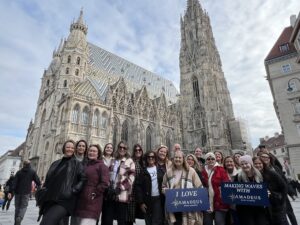
Defining Your Target Audience
Understanding your target audience is the first step in creating impactful travel content. By defining who you want to reach, you can tailor your messaging and visuals to resonate with their interests and needs. Consider the demographics, travel preferences, and unique characteristics of your ideal clients. Are you targeting honeymooners, luxury travelers, family vacationers, or corporate groups?
Tips for Identifying Your Target Audience:
- Analyze Past Clients: Look at common traits among your most loyal clients. This can reveal what resonates with potential new clients.
- Consider Your Expertise: Focus on destinations and types of travel you specialize in, such as luxury cruises or all-inclusive resorts.
- Engage with Followers: Conduct polls or Q&A sessions on social media to understand what your audience wants to see.
“Having a clear idea of who your clients are helps you shape content that appeals directly to their interests, making it more effective.”
Outlining Key Messaging for Your Trip
Creating key messages for your trip allows you to craft a cohesive story that aligns with your audience’s interests and your brand’s strengths. Think about the unique aspects of your destination or travel experience and how they relate to what your clients value.
Steps to Outline Key Messages:
- Highlight Unique Selling Points: What makes this destination or experience stand out? Showcase local culture, hidden gems, or exclusive perks.
- Connect with Audience Needs: Align messaging with what’s important to your audience—whether it’s luxury, family-friendly activities, adventure, or relaxation.
- Create a Consistent Theme: Decide on a few main themes to emphasize in your posts, such as relaxation, cultural immersion, or adventure.
Example Messaging: For a luxury-focused audience, key messaging might include, “Experience the pinnacle of relaxation at this exclusive resort” or “Indulge in curated experiences that redefine luxury travel.”
Researching Destination-Specific Content
Before your trip, dive into research on the destination to uncover the must-visit spots, cultural highlights, and activities that will be meaningful for your audience. Knowing what to capture ahead of time helps you showcase the destination’s unique appeal and keeps your content fresh and informative.
Research Tips:
- Look Up Top Attractions and Hidden Gems: Find a mix of iconic locations and off-the-beaten-path spots that match your audience’s interests.
- Explore Local Events or Festivals: Highlighting seasonal events adds a unique angle to your content.
- Check Competitor Content: See what other agents are sharing to understand trends and identify ways to stand out.
“The more you know about the destination, the more valuable and engaging your content will be. Clients want details they can’t easily find online.”
Setting Goals for Content Engagement and Lead Generation
Setting clear, achievable goals helps guide your content and measure its effectiveness. Are you looking to increase social media followers, drive more inquiries, or book consultations? Define your objectives and the metrics that will help you track your progress.
Steps to Setting Goals:
- Identify Primary Goals: Choose one or two main goals, such as increasing engagement on Instagram or generating new leads.
- Set Measurable Targets: Determine metrics to track, like the number of shares, comments, or inquiries you aim to receive.
- Plan for Call-to-Actions: Encourage followers to take action, like signing up for a newsletter or scheduling a consultation.
Example Goals:
- Engagement: Achieve a 20% increase in comments and shares on posts from this trip.
- Lead Generation: Capture 10 new leads through a trip-based email signup form or social media DMs.
“Setting specific goals allows you to focus your content strategy, making it easier to assess what resonates with your audience and drives results.”
By planning these elements before your trip, you’ll be better prepared to create focused, engaging content that captivates your audience and meets your business goals.
Content Strategy and Planning

Research Who and What are Already Successful
As an example, if you have an upcoming trip to the Danube for a river cruise, and you want to create a YouTube video covering this experience, go to YouTube and search for Danube river cruise. What videos have the most views, engagement, etc.? Copy and improve on what they're doing.
Selecting Content Types: Photos, Videos, Blog Posts, and Reels
Choosing the right mix of content types is essential for engaging your audience effectively. Each type offers unique advantages, allowing you to connect with clients in different ways. Consider the platforms where you’re most active and where your audience engages most.
Content Types to Consider:
- Photos: High-quality images showcase the beauty and appeal of your destination, capturing attention quickly.
- Videos: Short-form videos, like Reels, capture authentic experiences and are highly engaging, especially on Instagram and TikTok.
- Blog Posts: Longer, informative posts allow you to delve into details and position yourself as an expert. They’re perfect for SEO and for educating clients who want to learn more.
- Reels: Reels are ideal for capturing vibrant, quick snippets of your trip. They’re a great way to show highlights and attract new followers with trending sounds and visuals.
- Create Guides: Destination guides, travel planning guides, packing guides, activity guides, budgeting, special interests, etc. See our article Gaining Clients Using Guides.
“A well-rounded content plan includes a mix of photos, videos, and written posts, so there’s something for everyone. The variety keeps your audience engaged and makes it easy to share consistently.”
Mapping Out a Content Calendar
Creating a content calendar before your trip ensures you capture everything you need and keeps you organized. Plan which days you’ll post specific content types, and consider the best times to post based on your audience's online activity.
Steps for Building a Content Calendar:
- Set Posting Frequency: Decide how often you want to post during your trip. For example, post daily photos on Instagram and two Reels per week.
- Schedule Key Moments: Outline when and where you’ll capture and post significant events, like sunrise views, cultural tours, or luxury experiences.
- Adjust for Flexibility: Keep your calendar flexible so you can adapt to any unexpected opportunities or experiences.
Example Calendar:
- Day 1: Arrival post with an overview of the destination.
- Day 2: Morning Reel of a popular attraction, evening photo of a scenic spot.
- Day 3: Blog post draft on unique experiences or cultural highlights.
“Planning your posts ahead allows you to stay organized and capture everything you need without feeling overwhelmed.”
Brainstorming Destination Highlights to Feature
Identify specific highlights of the destination that will resonate with your audience. Think about what makes the location special and what your target clients would most enjoy seeing.
Destination Highlights to Consider:
- Iconic Landmarks: These are must-see spots that will attract immediate attention and encourage followers to engage.
- Hidden Gems: Showcasing lesser-known areas can help set you apart and make your content feel more authentic.
- Cultural Experiences: Highlight local festivals, foods, and traditions to provide a sense of immersion.
- Luxury and Unique Experiences: For high-end clients, focus on exclusive amenities, private tours, or unique accommodations.
“Clients love seeing authentic experiences. When you capture both the iconic spots and the hidden gems, it gives them a well-rounded view of the destination.”
Planning Interviews or Partnerships with Local Experts
Collaborating with local experts adds value to your content and positions you as an insider with access to unique insights. Interviews and partnerships can enhance your credibility and create more engaging, authentic content.
Steps for Partnering with Locals:
- Identify Potential Partners: Look for local guides, business owners, or cultural experts who align with your brand.
- Plan Content Around the Partnership: Decide if the partnership will be a video interview, a photo session, or a blog feature.
- Set Up the Logistics: Arrange meeting times and decide on key topics to discuss, ensuring the content feels natural and engaging.
Benefits of Partnering with Locals:
- Adds depth to your content by featuring firsthand insights.
- Helps foster connections within the destination for future collaborations.
- Increases credibility and shows clients you’re well-connected in the industry.
“Working with locals offers new perspectives and adds a level of authenticity to your content that’s hard to achieve on your own.”
Planning your content strategy with these elements will help you deliver a diverse, engaging, and highly shareable experience for your audience.
Packing for Content Creation
Become a Travel Agent: Unleash Your Full Potential
Ready for a career that's as fulfilling as it is rewarding? Becoming a travel agent with Vincent Vacations means building a business around your passion for travel.
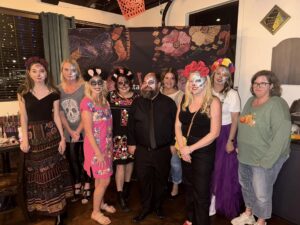
Essential Equipment Checklist: Cameras, Drones, Tripods, Lighting
To capture high-quality content, having the right equipment is crucial. Ensure you pack all necessary gear to create versatile and professional visuals, no matter the setting.
Must-Have Equipment:
- Camera: A DSLR or mirrorless camera for high-resolution photos.
- Smartphone: Ideal for on-the-go content, especially quick social media updates.
- Drone: For stunning aerial shots that capture the landscape.
- Tripod: Stabilizes shots and is essential for low-light or time-lapse photography.
- Portable Lighting: Handy for indoor or low-light settings, especially if shooting video.
“Bringing a range of equipment allows you to capture different aspects of the destination. Drones, for example, add a perspective that’s tough to get otherwise, making your content stand out.”
Tech Tools and Apps for Editing and Scheduling
Efficient content creation relies on having the right digital tools to edit, organize, and schedule posts, allowing you to maintain a consistent presence online.
Recommended Apps and Tools:
- Editing Apps: Use apps like Adobe Lightroom or VSCO for photos, and InShot or CapCut for video editing.
- Scheduling Tools: Planoly, Later, or Buffer are excellent for scheduling posts on Instagram, Facebook, and other platforms.
- Photo Storage: Cloud-based storage (like Google Photos or Dropbox) ensures you don’t lose any footage and can organize content easily.
- Notes and Ideas: Keep a note-taking app handy (such as Evernote or Notion) to jot down inspiration, captions, or ideas on the go.
“Scheduling tools and editing apps are essential. They keep your workflow efficient, so you can focus more on the experience while still posting regularly.”
Packing Props for Consistent Branding
Consistent branding helps you create a recognizable and cohesive look across all your posts. Packing a few small props can help you maintain this branding.
Ideas for Brand Props:
- Colorful Scarves or Accessories: Use these as a recurring theme to create a unique visual style.
- Portable Brand Signage: Small items like branded water bottles, hats, or notebooks subtly reinforce your brand.
- Travel Journal: A leather-bound or aesthetically pleasing journal that can appear in photos, adding a personal and professional touch.
“Using branded props adds a personal touch to your photos, making them more recognizable and cohesive.”
Quick Tips for Travel Gear Organization
Staying organized on the go helps protect your equipment and ensures that everything is accessible when you need it.
Tips for Organizing Gear:
- Use Packing Cubes: Separate electronic gear, chargers, and accessories in different cubes or pouches.
- Waterproof Cases: Keep electronics safe from unexpected weather changes, especially if you’re capturing beach or poolside content.
- Label and Check Cables: Bring spare cables and label them to avoid confusion or loss.
- Portable Chargers: Essential for long days of content creation to keep your devices powered up.
“Packing cubes and waterproof cases are life-savers. They keep your gear organized and protected, so you don’t miss a moment.”
With the right gear and organizational strategies, you’ll be well-prepared to create stunning, branded content efficiently throughout your trip.
Social Media Strategy

Pre-Trip Teasers and Announcements
Generating excitement before your trip can engage your audience and create anticipation for upcoming content. Teasers and announcements are a great way to build hype and let followers know to stay tuned for fresh updates.
Ideas for Pre-Trip Teasers:
- Countdown Posts: Share a countdown to your trip with enticing visuals or hints about the destination.
- Packing Previews: Showcase unique or must-have items for your trip to spark interest.
- “Guess the Destination” Polls: Create interactive posts where followers can guess your destination for increased engagement.
“Starting the conversation before you even leave creates anticipation and primes your audience to follow along.”
Identifying Trending Hashtags and Tags
Using trending hashtags and tags is essential for expanding your content’s reach and attracting new followers. Hashtags should be a mix of location-specific, niche, and general tags that relate to your content and audience.
Steps to Find Effective Hashtags:
- Research Destination Hashtags: Look up popular tags for the location, such as #CancunWeddings or #LuxuryMexico for destination-based posts.
- Use Niche Tags: Add niche-specific hashtags like #DestinationWeddingExpert or #LuxuryTravelAgent to attract a targeted audience.
- Incorporate Trending Travel Tags: Include popular travel tags such as #TravelGoals or #WanderlustWednesday to reach broader audiences.
Example Hashtags for a Destination Wedding Trip:
- Location-Based: #CaribbeanWeddings, #CancunResorts
- Niche-Specific: #LuxuryDestinationWedding, #BridalTravelExpert
- General Travel Tags: #TravelInspo, #AllInclusiveLuxury
“Finding the right mix of trending and niche hashtags helps your posts reach people who are genuinely interested in what you offer.”
Planning Content for Different Platforms (Instagram, Facebook, TikTok, YouTube, etc.)
Each social media platform has its own strengths and audience preferences, so tailoring content for each one will maximize engagement. Consider where your target audience is most active and the types of content that perform best on each platform.
Platform-Specific Content Ideas:
- Instagram: Focus on high-quality photos, Stories, and Reels. Highlight the aesthetic aspects of your trip with beautiful visuals and quick videos.
- Facebook: Share more in-depth posts and use albums for destination highlights. Facebook is also great for interactive polls and updates.
- TikTok: Create engaging, short videos that showcase unique moments and cultural experiences.
- YouTube: Consider posting longer, informative videos, such as “A Day in [Destination]” or a detailed guide on planning a destination wedding.
- LinkedIn: Long form articles do great on LinkedIn. Travel tips and hacks, seasonal highlights, budgeting tips, how-to articles, virtual tours, etc.
Example Strategy: Use Instagram for daily highlights and Stories, TikTok for fun, short clips, and YouTube for a post-trip recap video that dives into details.
“Planning content with platform-specific goals keeps each post relevant, reaching the right audience where they’re most engaged.”
Scheduling Posts Ahead of Time
Scheduling posts in advance allows you to maintain consistency without being glued to your phone during the trip. This can be especially helpful if you’re traveling to different time zones or if your itinerary is packed.
Steps to Schedule Posts:
- Plan High-Impact Posts: Schedule key posts, such as the start of your trip or visits to iconic spots, for peak engagement times.
- Use Scheduling Tools: Apps like Later, Buffer, or Hootsuite help you automate posting across multiple platforms.
- Prepare Captions and Hashtags in Advance: Write out captions and hashtag sets before you go, so you can focus on creating content.
Pro Tip: Use platform insights to determine the best posting times for your audience, ensuring maximum reach.
“Scheduling ahead gives you the freedom to enjoy your trip while staying consistent in your posting. It’s all about working smarter, not harder.”
A well-thought-out social media strategy will help you make a strong impact before, during, and after your trip, creating engagement momentum that drives client interest.
Engagement Strategy
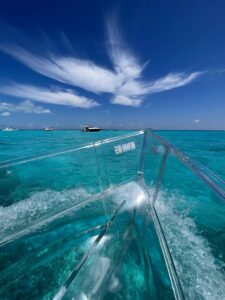
Crafting Captivating Trip Announcements and Teasers
Creating eye-catching trip announcements and teasers can spark excitement and draw your audience into your journey. Captivating announcements help set the tone for the trip and give followers a glimpse of what’s to come.
Tips for Effective Announcements and Teasers:
- Share Highlights to Expect: Mention specific locations, luxury accommodations, or unique experiences you’ll be covering.
- Use Engaging Visuals: Pair your announcement with a stunning photo or video to capture attention.
- Build Intrigue: Keep some details a mystery to encourage followers to stay tuned.
Sample Announcement: “Countdown to paradise! 🌴 I’m headed to [Destination] to explore its most luxurious spots and unique experiences. Follow along for daily updates on what makes this destination a must-see! 🌞✨”
“Exciting announcements make followers feel like they’re part of the journey, keeping them invested from the start.”
Developing Calls-to-Action for Engagement and Inquiries
A strong call-to-action (CTA) can drive interaction with your audience, helping you connect with potential clients and encourage inquiries about your services. Craft CTAs that inspire followers to engage, whether by commenting, sharing, or reaching out for more information.
Examples of Effective CTAs:
- Encourage Questions: “Curious about destination weddings in [Destination]? Ask me anything in the comments!”
- Invite Followers to Participate: “Which activity would you choose—relaxing by the pool or exploring the city? Comment below!”
- Drive Inquiries: “Thinking about planning your own dream getaway? DM me to learn more about how I can help!”
Pro Tip: Rotate between different CTAs to keep engagement fresh and encourage followers to connect in various ways.
“Clear, inviting calls-to-action guide your audience, making it easy for them to engage and inquire about your expertise.”
Preparing Templates for Responding to Comments and DMs
Responding promptly to comments and direct messages (DMs) shows followers that you’re attentive and engaged. Having prepared templates for common inquiries can streamline your responses and ensure you’re conveying key information effectively.
Tips for Creating Response Templates:
- Identify Common Questions: Consider what followers frequently ask about (e.g., travel tips, destination recommendations).
- Use Friendly Language: Maintain a welcoming tone to make followers feel valued.
- Personalize When Possible: Start with a template but personalize the message to make each response feel unique.
Sample Templates:
- For Comments: “Thanks so much for following along! I’m excited to share more about [specific experience] soon.”
- For Inquiries: “Hi [Name]! I’d love to help with your travel plans. Let’s chat about how I can create a customized itinerary just for you!”
“Using templates saves time, allowing you to keep up with engagement while providing followers with the responses they need.”
Setting Up a “Behind the Scenes” Story Plan
Behind-the-scenes content offers a more personal perspective, helping followers feel more connected to you and your journey. Sharing moments like your morning coffee ritual or setting up for a photo shoot can add depth and authenticity to your brand.
Ideas for “Behind the Scenes” Stories:
- Packing and Travel Prep: Show your packing essentials or any pre-trip rituals.
- Daily Routines: Share glimpses of your morning or evening routine at the destination.
- Funny or Unexpected Moments: Capture candid moments or small challenges, adding personality and relatability.
Pro Tip: Create a mix of planned and spontaneous behind-the-scenes content to keep your stories fresh and engaging.
“Behind-the-scenes content gives your followers a sense of authenticity. They love seeing the little moments that make a trip real.”
By implementing these engagement strategies, you’ll not only captivate your audience but also build genuine connections that foster loyalty and trust in your services.
Creating a Brand Consistent Look
Establishing a Color Palette and Editing Style
Maintaining a consistent color palette and editing style across your content helps create a recognizable and cohesive look. This branding consistency makes your posts more professional and memorable to followers.
Steps to Define Your Brand’s Color Palette and Style:
- Choose a Primary Color Scheme: Select colors that reflect your brand's vibe. For a luxury feel, consider deep blues, golds, or muted tones; for a vibrant look, try tropical or pastel shades.
- Develop an Editing Style: Use filters or presets that complement your chosen palette. This could mean adjusting brightness, contrast, or saturation to maintain a consistent aesthetic.
- Use Apps for Editing Consistency: Editing apps like Lightroom offer preset options that make it easy to apply the same look to all your photos.
“Consistency in colors and editing styles helps create a visual brand identity that followers recognize instantly.”
Tips for Taking High-Quality Photos and Videos
Capturing high-quality visuals is essential for engaging your audience. Quality images and videos communicate professionalism and help your posts stand out in a crowded feed.
Tips for Taking Great Photos and Videos:
- Focus on Lighting: Natural light is ideal for capturing crisp, vibrant images. Early mornings and late afternoons (the “golden hours”) offer the best light.
- Pay Attention to Composition: Use the rule of thirds and look for interesting angles to add depth to your shots.
- Keep Steady for Videos: Use a tripod or gimbal to stabilize videos and avoid shaky footage.
Pro Tip: Capture multiple shots of the same scene with different angles or lighting to have options for editing later.
“High-quality visuals aren’t just about the camera you use; they’re about being intentional with angles, lighting, and framing.”
Adding Captions and Text to Videos to Increase Engagement
Adding captions or text overlays to your videos can make content more accessible and engaging, especially for users watching with the sound off. Captions also highlight key messages and increase the likelihood of viewers watching to the end.
Tips for Using Captions and Text:
- Highlight Key Points: Use text to emphasize important details, like the name of a landmark or a travel tip.
- Use Contrasting Colors: Ensure text is easy to read against the background by choosing contrasting colors.
- Keep It Brief: Short, impactful captions work best on platforms like Instagram Stories and Reels.
Example Text Overlay: “Experience the luxury of [Resort Name]—your perfect destination wedding awaits! 🌴✨”
“Text overlays help convey your message, making videos more accessible and engaging for a wider audience.”
Brand Voice and Tone for Posts
Your brand’s voice and tone are essential for creating a consistent feel across all posts. A defined voice builds familiarity with your audience and reinforces your brand identity.
Developing Your Brand Voice:
- Define Your Tone: Decide if your voice is formal, friendly, adventurous, or luxurious based on your target audience.
- Use Consistent Language: Stick to a set of key phrases or stylistic choices. For example, using descriptive words like “exclusive,” “luxurious,” or “hidden gem” for luxury-focused content.
- Align with Audience Expectations: If you’re targeting wedding clients, your tone might be celebratory and romantic, while a focus on adventure might call for an enthusiastic, energetic tone.
“Your brand’s voice shapes how clients perceive you, creating a feeling of familiarity and trust in your expertise.”
With a consistent brand look, voice, and visual quality, your content will resonate more strongly with followers, making it easy for potential clients to recognize and connect with your brand.
Networking Opportunities
How to Connect with Local Businesses and Influencers
Building relationships with local businesses and influencers can add depth and authenticity to your content while expanding your network. These connections often lead to unique content opportunities and valuable insights into the destination.
Tips for Connecting Locally:
- Reach Out in Advance: Contact local businesses, guides, or influencers before your trip to establish a connection and explore collaboration options.
- Use Social Media: Platforms like Instagram and LinkedIn make it easy to find and engage with local experts. A simple DM or comment can open doors.
- Offer Mutual Benefits: Be clear about how collaboration can benefit both sides—whether by cross-promoting each other or offering exposure to new audiences.
“Networking with locals adds a layer of authenticity that clients appreciate, making them feel like you have insider knowledge of the destination.”
Planning Meetups with Potential Clients or Partners
If you’re visiting a popular destination, organizing meetups with potential clients or partners can create meaningful, face-to-face connections. This not only builds trust but also gives you the chance to showcase your expertise directly.
Ideas for Planning Meetups:
- Host a Small Event: Arrange a coffee meet-up or a casual gathering at a popular local spot. You could even invite existing clients who are interested in the destination.
- Leverage Social Media: Announce your plans on social media to gauge interest. You may find that followers who are nearby want to join.
- Partner with a Local Business: Collaborate with a local café, shop, or activity provider for a co-hosted event that draws in more people and adds value to the experience.
Pro Tip: Collect contact information during meetups to follow up and strengthen the connections after your trip.
“Face-to-face interactions allow you to connect on a deeper level. Clients are more likely to trust your advice when they’ve met you in person.”
Taking Advantage of Destination Experiences for Content
Using local experiences as content opportunities helps you authentically showcase the destination while highlighting your ability to curate unique travel experiences. These moments allow your audience to “see” the destination through your eyes, making your content more immersive and engaging.
Tips for Maximizing Destination Experiences:
- Capture Key Moments: Focus on authentic experiences, like trying local cuisine, taking part in cultural activities, or exploring hidden spots.
- Emphasize Sensory Details: Describe the sights, sounds, and tastes to help your audience feel like they’re there with you.
- Be Selective: Not every experience will resonate with your audience, so choose moments that align with their interests and your brand message.
Example: “Showcasing a traditional market visit allows followers to experience the local culture alongside you, making the destination more accessible and appealing.”
“Clients want more than just photos of pretty places—they want to feel the experience and see the authentic side of the destination.”
Gaining Exclusive Access or Experiences for Unique Content
Securing exclusive experiences can set your content apart and position you as a well-connected, knowledgeable travel expert. Unique access allows you to capture content that’s fresh, exclusive, and highly shareable.
Strategies for Gaining Exclusive Access:
- Partner with Hotels or Resorts: Many luxury properties offer exclusive tours or VIP experiences for travel professionals that provide unique content opportunities.
- Collaborate with Local Experts: Arrange for private tours or behind-the-scenes access with local guides to discover hidden gems not available to the general public.
- Explore Seasonal Events: Attend local festivals or seasonal events that provide a one-of-a-kind experience, making your content more engaging.
Pro Tip: Use these exclusive moments to highlight your insider connections and show potential clients the added value of booking through you.
“Exclusive experiences position you as a travel insider, showing clients that you can offer something unique that they can’t easily find on their own.”
Utilizing networking opportunities during your trip not only enriches your content but also strengthens your reputation as a connected, resourceful travel expert. These connections and experiences add immense value to your brand, setting you apart from competitors.
Trip Itinerary Planning for Content
Organizing Destinations to Maximize Content Opportunities
Careful planning of your itinerary allows you to capture diverse, engaging content throughout your trip. By organizing destinations strategically, you can ensure you’re maximizing content opportunities without feeling rushed or overwhelmed.
Tips for Organizing Destinations:
- Group Nearby Locations: Arrange visits to nearby attractions on the same day to save time and energy, which can be redirected toward creating content.
- Prioritize High-Impact Spots: Schedule time at well-known or visually stunning locations during optimal lighting (e.g., sunrise or sunset) for better photos and videos.
- Balance Busy and Relaxed Days: Mix in lower-energy activities on busier days to allow yourself time to focus on capturing quality content rather than rushing from place to place.
“Organizing your itinerary with content in mind ensures you don’t miss out on key moments, helping you balance exploration and content creation.”
Identifying “Must-Capture” Locations and Experiences
Some locations and experiences are essential to include in your content, especially those that are iconic or unique to the destination. These must-capture moments will resonate with your audience and can become focal points for your trip’s storytelling.
How to Identify Must-Capture Moments:
- Research Iconic Spots: Look up popular attractions, landmarks, or scenic vistas that are synonymous with the destination.
- Focus on Unique Experiences: Consider capturing exclusive experiences that show the essence of the destination, such as cultural performances, local dining, or traditional ceremonies.
- Plan for Diverse Angles: Capture different perspectives of must-see locations, such as wide shots of landscapes and close-ups of cultural details.
Example Must-Capture Locations: For a trip to Santorini, you might include shots of the iconic blue-domed churches, cliffside sunsets, and a traditional Greek meal.
“Identifying must-capture spots ensures you get the most meaningful content, offering your audience a genuine feel for the destination.”
Balancing Work and Personal Time for Authentic Content
While capturing content is important, it’s equally vital to experience the destination authentically. Balancing content creation with personal enjoyment allows you to create more genuine, engaging posts.
Tips for Balancing Work and Personal Time:
- Set Content-Free Time: Designate certain times of the day where you simply enjoy the moment without capturing anything. This can help you recharge and bring fresh enthusiasm to your content.
- Combine Personal Moments with Micro-Content: Use personal moments as inspiration for micro-content, such as sharing a quick reflection or a candid snapshot, to make content feel more genuine.
- Focus on Enjoying Key Experiences First: Experience the moment fully before capturing it. This helps ensure your reactions and posts feel authentic rather than staged.
“Audiences can tell when content feels forced. Striking a balance between work and enjoyment brings out a more relatable, authentic side.”
Tips for Maximizing Downtime with Micro-Content
Use downtime to capture quick, informal content that keeps your audience engaged between major posts. Micro-content is a great way to keep a steady stream of updates without requiring extensive effort.
Ideas for Micro-Content:
- Short Clips or Snaps: Capture quick snippets of your surroundings, like a glimpse of a local market or a walk through a scenic spot.
- Daily Reflections or Thoughts: Share a short message or thought about your day’s experience—this could be a favorite moment or a quick travel tip.
- Behind-the-Scenes Moments: Show candid moments, like enjoying a coffee at a local café or preparing for an excursion.
Pro Tip: Keep your phone or camera easily accessible for quick captures, allowing you to take advantage of spontaneous moments.
“Using downtime for micro-content allows you to keep followers engaged without overwhelming yourself with constant production.”
Effective itinerary planning for content ensures you capture a mix of high-quality and spontaneous moments, creating a dynamic and engaging narrative that resonates with your audience.
Post-Trip Follow-Up
Organizing and Editing Content for Future Posts
After your trip, organizing and editing your content is key to maintaining a steady flow of posts that keep your audience engaged. Sorting through your photos, videos, and notes allows you to build a content library that you can draw from for weeks or even months.
Tips for Organizing and Editing Content:
- Create Folders by Category or Theme: Sort content into folders based on themes (e.g., “Landscapes,” “Cultural Experiences,” “Luxury Accommodations”) for easier access.
- Use Editing Apps to Maintain Consistency: Apply your brand’s color palette or filters to maintain a cohesive look across all posts.
- Save for Multiple Uses: Keep backup copies of all high-quality content for repurposing in blog posts, social media, or newsletters.
“Organizing your content post-trip saves time and ensures you have a library of ready-to-use material, so you can maintain momentum even after the trip.”
How to Build Engagement Momentum Post-Trip
Building engagement doesn’t end when your trip is over. Sharing post-trip reflections, additional insights, and highlights helps keep your audience interested and creates opportunities to connect with potential clients who were following along.
Strategies to Sustain Engagement:
- Post Recaps and Highlights: Share a “best of” photo carousel, video montage, or recap post showcasing top moments from the trip.
- Engage Through Q&A Sessions: Host a Q&A on Instagram Stories or Facebook Live where followers can ask questions about the destination or travel tips.
- Share “Missed Moments” or Outtakes: Posting fun, unedited moments adds authenticity and gives followers a behind-the-scenes view.
“Building engagement post-trip keeps the conversation going and brings new value to the content you’ve already captured.”
Using Trip Content for Blog Posts, Newsletters, and Guides
Repurposing trip content for longer formats, such as blog posts, newsletters, and travel guides, allows you to provide more value and in-depth information to your audience. These formats are perfect for establishing authority and nurturing leads.
Ideas for Repurposing Trip Content:
- Write a Destination Guide: Share tips, must-see spots, and insights into the local culture to create a comprehensive travel guide.
- Send a Trip Recap Newsletter: Use a newsletter to summarize your trip, include best photos, and highlight services for clients interested in similar experiences.
- Create “How-To” Blogs: Write blog posts that provide practical advice based on your trip, such as “How to Plan a Destination Wedding in [Destination].”
Pro Tip: Link these posts back to your social media channels to drive traffic and engagement across platforms.
“Repurposing content gives you more mileage out of your trip, adding depth and value to your online presence.”
Following Up with Leads Generated from Trip Marketing
Your trip may have generated inquiries and interest from potential clients. Following up promptly and professionally with these leads is essential for turning interest into bookings.
Steps for Effective Follow-Up:
- Organize Leads: Create a list of inquiries or DMs received during the trip and categorize them by interest or destination.
- Personalize Your Responses: Reference specific content they engaged with or questions they asked to make your communication feel personal and relevant.
- Offer Next Steps: Provide a clear path forward, such as scheduling a consultation call, sending a custom itinerary, or inviting them to sign up for a newsletter.
Example Follow-Up Message: “Hi [Name], thank you for following along on my journey to [Destination]! I’d love to help you plan a similar experience. Let’s chat about how I can make your dream trip a reality!”
“Timely, personalized follow-ups help convert leads into loyal clients by showing that you’re attentive and ready to help with their travel needs.”
By following these post-trip strategies, you’ll maintain the momentum built during your trip, turn engagement into lasting connections, and leverage your content for ongoing marketing success.
Measuring Success and Analyzing Results
Tracking Engagement, Reach, and New Client Leads
After your trip, it's essential to assess how your content performed across social media and other platforms. Tracking metrics like engagement, reach, and lead generation provides valuable insight into what resonated with your audience and how effectively you connected with potential clients.
Key Metrics to Track:
- Engagement Rate: Monitor likes, comments, shares, and saves on each post to see what type of content your audience found most engaging.
- Reach and Impressions: Check how many people saw your content and how frequently, helping you understand your overall exposure.
- Lead Generation: Track the number of inquiries, consultations, or new client sign-ups directly attributed to the trip content.
“Measuring engagement and reach gives you a clear picture of what’s working and allows you to focus on the content that resonates most.”
Evaluating What Worked and What Didn’t
Analyzing the success of your content involves identifying what performed well and what didn’t. Understanding the elements that drove engagement and connection with your audience will help refine your strategy for future trips.
Steps for Evaluation:
- Review Top-Performing Posts: Look for patterns among posts with high engagement, such as popular locations, types of photos, or specific topics.
- Identify Underperforming Content: Take note of posts that had low engagement to identify any common factors, like timing, captions, or visuals.
- Ask for Feedback: Poll your audience or invite comments to learn what they enjoyed most and what they'd like to see in the future.
Pro Tip: Keep a content performance journal to document what worked and what didn’t, so you can apply these insights on your next trip.
“Analyzing what worked and what didn’t is crucial. It allows you to refine your content strategy, focusing on what your audience values most.”
Setting Goals for Future Trips Based on Data
Using the data from your recent trip’s performance, set clear, achievable goals for your next trip. These goals should be based on the insights gained from tracking engagement, reach, and lead generation.
Examples of Data-Driven Goals:
- Increase Engagement: Set a goal to achieve 25% more likes, comments, or shares by focusing on high-performing content types.
- Expand Audience Reach: If you found success with specific hashtags or collaborations, aim to increase reach by using similar tactics.
- Boost Lead Conversion Rate: Improve your conversion process by refining CTAs or personalizing follow-ups to increase inquiries and bookings.
“Data-driven goals give your strategy direction, allowing you to measure progress and adjust your approach for maximum impact.”
Leveraging Insights for Future Marketing Strategies
The insights gained from analyzing your trip’s performance should inform your broader marketing strategy. By integrating these learnings, you can strengthen your overall content approach, client engagement, and lead generation efforts.
Ways to Apply Insights to Future Marketing:
- Refine Content Themes: Focus on themes that resonated most with your audience, such as cultural experiences, luxury accommodations, or adventure activities.
- Enhance Personalization: Tailor your messaging and offers based on what you learned about your audience’s preferences and travel desires.
- Optimize Posting Schedule: If certain times or days performed better, adjust your posting schedule accordingly to maintain engagement momentum.
Pro Tip: Continuously refine your strategy by integrating feedback, engagement data, and audience trends, making each trip more impactful than the last.
“Leveraging insights from each trip allows you to continually improve, ensuring your content remains relevant and effective in engaging clients.”
By effectively measuring and analyzing your results, you’ll gain valuable insights to enhance your future marketing strategies, optimize your content approach, and grow your client base consistently.
Conclusion
Recap of Key Takeaways
Successfully marketing your trip online requires careful planning, strategic content creation, and post-trip analysis. By applying each step covered in this guide, you can maximize your trip’s impact, reach new clients, and grow your travel business.
Key Takeaways:
- Pre-Trip Planning: Define your target audience, plan your messaging, and set clear engagement goals.
- Content Strategy: Use a mix of content types—photos, videos, blog posts, and reels—to keep your audience engaged across multiple platforms.
- Engagement Strategy: Craft captivating announcements, utilize calls-to-action, and prepare templates for efficient communication with followers.
- Networking and Unique Experiences: Leverage local connections to add depth and exclusivity to your content.
- Post-Trip Follow-Up: Organize your content, engage with your audience, and repurpose materials to maintain interest after the trip.
- Measuring Success: Analyze your results to identify what worked, set future goals, and improve your strategy based on data.
“A successful marketing strategy doesn’t end with a single trip—it’s about learning, growing, and continuously refining your approach to attract and retain clients.”
Planning for Future Trips and Marketing Growth
Each trip is an opportunity to refine your marketing approach. Use insights from past trips to shape your future content strategy, focusing on what resonates most with your audience and attracts potential clients.
Steps for Future Planning:
- Set Clear Objectives for Each Trip: Define goals specific to each trip, whether it’s reaching a broader audience, showcasing a new destination, or driving client inquiries.
- Build on Previous Successes: Focus on content types, themes, and tactics that proved effective, such as engaging visuals, compelling storytelling, or exclusive experiences.
- Stay Informed on Trends: Keep up with social media trends, platform updates, and popular hashtags to ensure your strategy remains fresh and relevant.
Pro Tip: Use each trip to experiment with new ideas and formats, allowing you to diversify your content and explore what resonates best with your audience.
“Consistent growth in your marketing strategy comes from continually learning, evolving, and applying insights to future trips.”
Keeping Momentum and Consistency in Your Marketing Strategy
Consistency is key to building a strong, recognizable brand. By maintaining a steady flow of high-quality, engaging content, you can keep your audience’s attention, stay top-of-mind, and position yourself as a trusted travel expert.
Tips for Maintaining Momentum:
- Plan Content in Batches: Schedule and organize your posts in advance to ensure consistent posting, even during busy times.
- Use a Content Calendar: Map out a long-term plan that includes not just trip content but also industry insights, travel tips, and seasonal trends to stay relevant.
- Engage Regularly: Interact with your audience between trips by sharing tips, responding to comments, and keeping conversations alive.
“Consistency isn’t just about posting frequently; it’s about staying engaged, relevant, and adding continuous value to your audience.”
By following this guide, you’ll be able to transform each trip into a valuable marketing asset, strengthen your online presence, and grow your client base effectively. Remember, each trip is an opportunity to connect, inspire, and showcase your expertise as a travel agent. Keep learning, adapting, and refining your approach, and you’ll build a lasting and impactful marketing strategy for your travel business.
Learn more about this by signing up for one of our online trainings Learn More
To learn more techniques and how to become a travel agent, sign-up to become a travel agent today!

